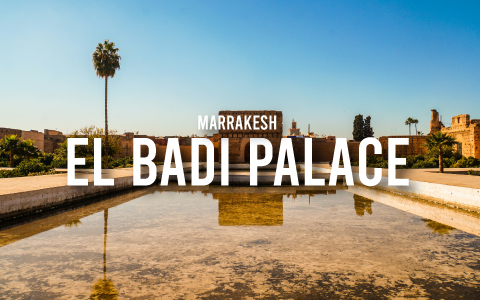
The Haunting Beauty of El Badi Palace, Marrakesh
Known as the “Red City” due to its rose-tinted buildings and walls, Marrakesh hides vibrant souks, serene gardens, and iconic attractions that captivate visitors from all over the world. A few examples? The bustling Jemaa el-Fnaa square, the intricate beauty of the Bahia Palace, the lush Majorelle Gardenand El Badi Palace.
A Glimpse Into History of El Badi Palace
El Badi Palace, meaning “The Incomparable Palace,” was commissioned by Sultan Ahmed al-Mansur of the Saadian dynasty in the late 16th century to celebrate his victory over the Portuguese at the Battle of the Three Kings in 1578.
Designed to showcase the wealth and power of the dynasty, the palace was constructed using some of the most lavish materials of the time, including Italian marble, Indian onyx, and gold imported from Sudan.
For nearly a century, El Badi stood as a magnificent royal residence and a symbol of Moroccan grandeur. However, in the 17th century, Sultan Moulay Ismail ordered the dismantling of the palace, repurposing its materials to construct his own capital in Meknes. What remains today is a sprawling ruin that whispers stories of its former glory. The remnants still exude a sense of majesty with its grand courtyards, sunken gardens, and reflecting pools that hint at the architectural brilliance of its heyday.
What to See at El Badi Palace
One of the most striking features of El Badi is its immense central courtyard, which once housed a large pool flanked by citrus orchards. The pool’s empty expanse, bordered by red clay walls, creates a serene and hauntingly beautiful atmosphere. Visitors can also explore the underground dungeons and passageways, which add an air of mystery to the experience.
The restored Koutoubia Minbar, a historic pulpit originally from the Koutoubia Mosque, is one of the key attractions within the palace complex. This intricately carved and beautifully decorated piece, made from cedarwood and inlaid with ivory and precious metals, shows the artistic craftsmanship of the Saadian era.
Other highlights include the panoramic views from the palace’s towers, which offer stunning perspectives of Marrakesh and the distant Atlas Mountains. Storks have made their nests atop the ruins, adding a touch of life and charm to the historic site.
Throughout the palace grounds, remnants of mosaics and fragments of carved plasterwork remind the opulence that once defined this royal residence. Informational plaques and exhibits provide insight into the history and significance of the palace, making it an enriching experience for history enthusiasts.
Getting to El Badi Palace and Exploring the Area
El Badi Palace is located in the heart of Marrakesh’s Medina, just a short walk from Jemaa el-Fnaa square. Its central location makes it easily accessible by foot or by taxi.
The palace’s entrance fee is modest, and guided tours are available for those who wish to delve deeper into its history. Audio guides and detailed signage on-site also provide a wealth of information for self-guided exploration.
Once you’ve explored El Badi Palace, there are several nearby attractions to enhance your visit. The Saadian Tombs, another remnant of the Saadian dynasty, are just a stone’s throw away. These tombs are renowned for their exquisite tilework and intricate carvings. The Bahia Palace, a short walk from El Badi, offers a contrasting experience with its well-preserved interiors and lush gardens. Finally, the Medina itself, where the aromas of spices, the calls of vendors, and the colors of handcrafted goods create an unforgettable sensory experience.



